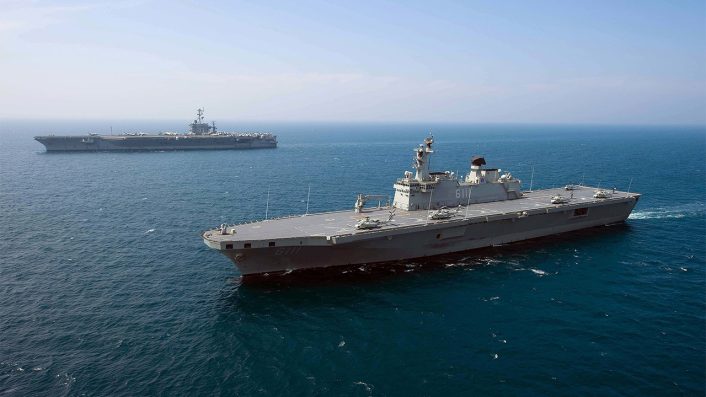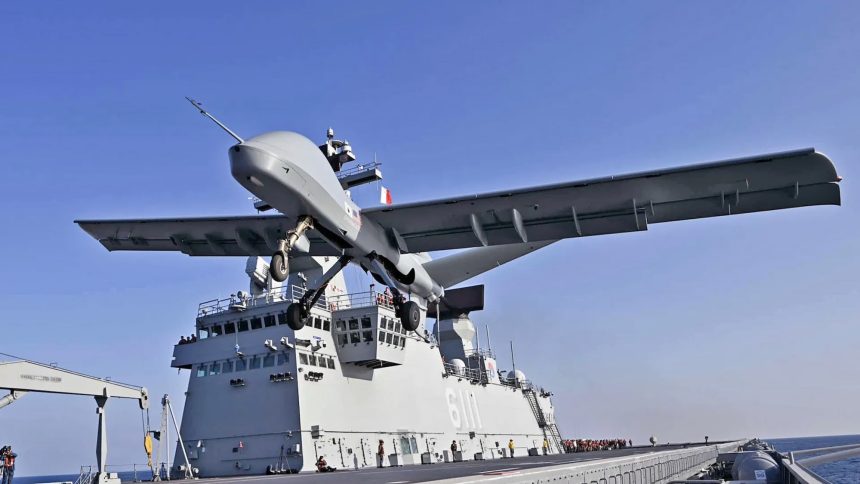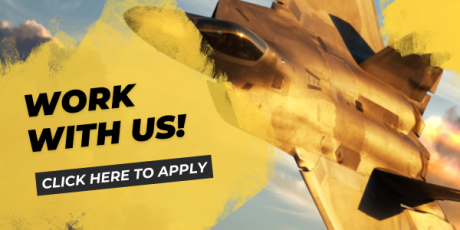GA-ASI announced a deal with Hanwha Aerospace that will see collaboration on the development and production of unmanned aircraft systems.
General Atomics Aeronautical Systems, Inc (GA-ASI) announced a deal with South Korean firm Hanwha Aerospace that will see collaboration on the development and production of unmanned aircraft systems (UAS).
Linden Blue, Chief Executive Officer of GA-ASI, which is a UAS focused subsidiary of General Atomics, said: “We’re excited to extend and deepen our business relationship with Hanwha”. He added that “Our test flight with Gray Eagle STOL was well-received by the Republic of Korea Navy, and we know Hanwha is ready to invest to grow a UAS business with GA-ASI both in Korea and the U.S.”
GA-ASI’s MQ-1C Gray Eagle-derived short take-off and landing (STOL) aircraft successfully completed flight trials from the Republic of Korea Navy landing ship ROKS Dokdo (LPH-6111) in November 2024. During these trials the drone took off from the ship, but a landing on the deck was not attempted.
Gray Eagle STOL, also known under the name Mojave, is designed specifically for operations from ships without catapult launch or arrested recovery systems. It has also been trialed from the Royal Navy’s HMS Prince of Wales.

Hanwha Aerospace is one of the largest defense contractors in the Republic of Korea. The subsidiary was formerly owned by and named after technology giant Samsung until all shares were sold to the Hanwha Group in the mid 2010s.
Alongside being South Korea’s only manufacturer of gas turbine engines, Hanwha Aerospace has achieved export success on the global stage with the K9 Thunder self-propelled howitzer selling to Poland, Turkey, India, and Finland, among others.
Hanwha Aerospace to supply KF-21 fighter jet engines under $401 million deal https://t.co/p6s4hR2ofM pic.twitter.com/COi29Rh0ve
— Shephard News (@ShephardNews) June 26, 2024
As part of the new deal with GA-ASI, Hanwha Aerospace plans to invest more than 300 billion South Korean Won (US$203.5 million) in development and production facilities for UAS engines, and increasing general research and development activities in the field of unmanned aircraft.
Dong Wan Kim, Vice Chairman of Hanwha Group, stated “Hanwha Aerospace views unmanned systems as a strategic pillar for the future of defense. Through our collaboration with GA-ASI, we aim to strengthen sovereign defense capabilities, expand Korea’s presence in the global UAS market, and contribute to a more robust ROK-U.S. alliance”.
South Korean Unmanned Aircraft
South Korea produces a number of locally designed unmanned aircraft. Korea Aerospace Industries (KAI) has offered the unarmed intelligence, surveillance, and reconnaissance (ISR) RQ-101 Songgolmae since 2000, with an unknown number of units in service with the Republic of Korea Army. Development of this aircraft has reportedly ceased, with KAI focused on newer models like the proposed NCUAV.
The aerospace research division of flag carrier airline Korean Air teamed up with the government Agency for Defense Development to design the Korean Unmanned System–Flight Strategic (KUS-FS) UAV, which is roughly equivalent in specifications to the MQ-9 Reaper. Mass production of the KUS-FS, formerly known as MUAV, began in 2024, and it appears to have entered at least limited service.
Apr. 10, 2025#Seoul Air Base, South Korea #MDL #NoCALLSIGN #71F392 ROKAF KUS-FS MUAV pic.twitter.com/3pxtVs9wit
— Heo TaeJin (@AIYeyENGDdJkjTr) April 9, 2025
High end ISR taskings are undertaken by a fleet of four RQ-4B Global Hawks procured from the United States. These high-altitude UAVs are frequently seen operating along the country’s northern border, collecting intelligence from the Democratic People’s Republic of Korea (DPRK, commonly referred to as North Korea).
South Korea has been operating RQ-4 Global Hawks for a few years. 1st time I have seen one of them on a tracking sight along the DMZ ( do see/ use to see USAF RQ-4s but not as much in this area in the last several months)
Up for last 20hrs #71F64A pic.twitter.com/6k9mKERw6Y
— RivetJoint (@SpeckleBelly64) February 9, 2024
The DPRK has frequently shown off its unmanned aircraft developments, including locally produced copies of American designs like the Global Hawk and MQ-9 Reaper.
More pertinent for South Korean defense concerns is the proliferation of smaller UAVs, including commercial or commercial-like quadcopters, and ‘suicide’ drones, which have proven their effectiveness in the Middle East and in Ukraine. A number of smaller UAVs have been monitored crossing the border, triggering an armed response from South Korean military forces.
By partnering with an established UAV firm, like GA-ASI, South Korea will establish a good opportunity to increase its unmanned arsenal and prevent its rival from gaining an advantage by leveraging further technology transfers from allies Russia and Iran.









